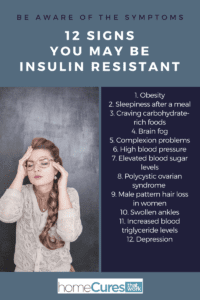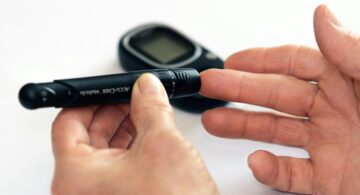12 Signs That You May be Insulin Resistant
Natural Ways to Prevent Diabetes
Insulin is the hormone that facilitates the transport of glucose, or blood sugar, from the bloodstream and into the body’s cells to use for energy. After eating a meal, in response to the normal increase in blood sugar, the pancreas secretes insulin into the bloodstream. If you become insulin resistant, the normal amount of insulin that’s secreted isn’t sufficient enough to carry blood sugar into the cells, so to compensate the pancreas continues to increase the amount of insulin secreted to help maintain adequate glucose movement into the cells, and a healthy blood sugar level.
If that sounds a bit too complicated, it can be summed up simply by saying, when insulin resistance occurs, your blood sugar level rises.
The Problems with Insulin Resistance
While most people connect diabetes to the word insulin, problems with insulin can result in multiple different conditions in those with normal blood sugar levels, including:
- Heart attack
- Stroke
- Fatty liver
- Obesity
- High cholesterol
- High blood pressure
Being insulin resistant can also lead to the development of prediabetes or full on diabetes.
Prediabetes typically occurs in those who are already insulin resistant – while the condition alone doesn’t cause type 2 diabetes directly, it can set the stage for the disease due to the high demands it places on cells that produce insulin. When one has prediabetes, their cells are no longer able to produce enough insulin to overcome insulin resistance, resulting in blood glucose levels that are higher than normal.
Once someone has prediabetes, the continued loss of that proper cell functioning typically leads to type 2 diabetes, and over time, that can cause serious complications like stroke, heart disease, kidney failure, lower limb amputations and blindness.
12 Signs You May Be Insulin Resistant
Obviously, no one wants to be insulin resistant, but frighteningly one in three Americans are said to be affected by this condition, which happens to correlate with the country’s dismal rates of obesity – currently at 34.9 percent.
By being aware of the signs of insulin resistance, you can take action now, before it’s too late.
1. Obesity
Obesity, as noted, and especially abdominal obesity is a sign of being insulin resistant. That’s because as your waist gets larger, insulin isn’t able to work in the body as it should, ultimately causing levels of this hormone to rise.
2. Sleepiness after a meal
As insulin is unable to do its job properly, your cells aren’t receiving the fuel they need, resulting in fatigue and sometimes extreme sleepiness especially after eating.
3. Craving carbohydrate-rich foods
If you’re insulin resistant, you may feel hungry constantly, and as carbs tend to be especially satisfying to an insatiable appetite, this is what you crave most often.
4. Brain fog
If you have an inability to focus, or trouble thinking, insulin resistance could be the cause. That’s because cells in the brain known as “microglia” release inflammatory messages when you have the condition, creating a vicious cycle of brain fog that not only muddies the thoughts but can destroy brain tissue.
5. Complexion problems
If you have acne and large pores on your face, it could be because being insulin resistant promotes higher levels of testosterone and increased sensitivity of the face to the male hormone, which makes you more susceptible to acne.
6. High blood pressure
Many people with hypertension are either pre-diabetic or diabetic, and have higher insulin levels due to insulin resistance as one of the insulin’s effects is to control arterial wall tension.
7. Elevated blood sugar levels
Having a fasting blood glucose level over 95mg/dL indicates insulin resistance. Studies have shown that those with a fasting blood sugar level in the upper limit of normal range (95 to 99mg/dL) were 2.33 times more likely to develop type 2 diabetes than those who tested at less than 85mg/dL.
Fight Type 2 Diabetes with... Tree Bark?
8. Polycystic ovarian syndrome
This common endocrine system disorder among women of reproductive age is often linked to higher insulin levels.
9. Male pattern hair loss in women
Rendering insulin ineffective affects multiple body processes, including hair growth. A study published in the European Journal of Cardiovascular Risk found that women with some markers of insulin resistance have a greater risk for androgenic alopecia or female pattern baldness.
10. Swollen ankles
Because insulin sends a message to your kidneys to hold onto water and sodium, you’ll look puffier, and may notice swollenness in the ankles as well the fingers, face, abdomen or other parts of the body.
11. Increased blood triglyceride levels
While having high triglycerides doesn’t cause diabetes, it does indicate insulin resistance, and that your system isn’t working properly when it comes to turning food into energy. When your cells don’t let insulin into your cells, both glucose and triglycerides build up in the blood.
12. Depression
Depression can be due to a “deranged metabolism” that results from insulin resistance.
What To Do Now If You Are Insulin Resistant
If you’re insulin resistant, the good news is that you can take control by addressing it now.
Lose weight. Even a small amount of weight loss can help to reduce insulin resistance. By following the diet and exercise tips that follow, weight loss is often a natural result.
Change your diet. Restrict your carbohydrate intake by eliminating processed and fast foods, instead focusing on getting your carbs from nuts and seeds, vegetables and small amounts of fruit. Include moderate amounts of healthy fats, from sources like avocados, coconut oil, extra-virgin olive oil and nuts instead of following a strict low-fat diet. You should also include cold-water fish like wild-caught salmon, which is high in omega-3 fatty acids that can help combat the pro-inflammatory effects of insulin improving the cells’ response to the hormone.
Get regular exercise. Getting regular exercise is a must for a healthy body and mind, as well as combatting insulin resistance. Vigorous cardio exercise helps to decrease the cells’ resistance to insulin. Aim for 30 minutes per day, but if you haven’t been exercising, you’ll need to slowly work up to that amount. Also, don’t forget the value of resistance training. It all matters and will make a huge difference in how your body looks and feels.
Accidental Study from Duke University Reverses Diabetes. Study shows how to get blood sugar under control in as little as 4 weeks. Click here to discover this scientifically-backed way to be healthy and diabetes-free!!

























